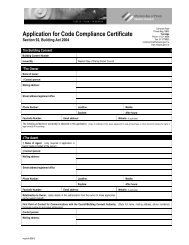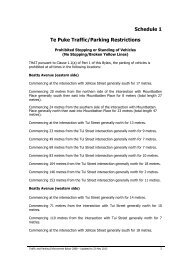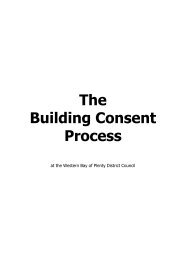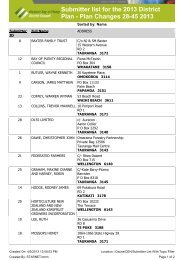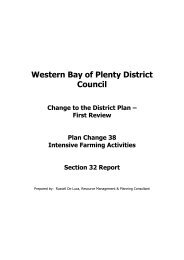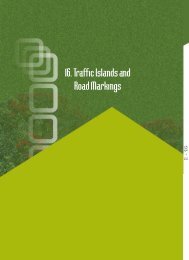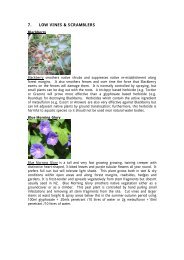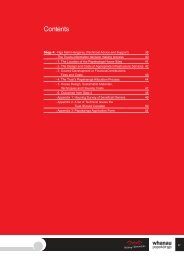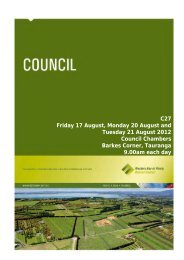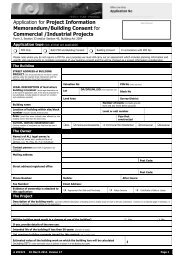Te Puna Plan - Western Bay of Plenty District Council
Te Puna Plan - Western Bay of Plenty District Council
Te Puna Plan - Western Bay of Plenty District Council
You also want an ePaper? Increase the reach of your titles
YUMPU automatically turns print PDFs into web optimized ePapers that Google loves.
overcapitalisation <strong>of</strong> land (making it difficult for new rural ventures to find land at a reasonable<br />
price due to the value <strong>of</strong> capital improvements to the land such as houses)<br />
decrease in versatility <strong>of</strong> land (this being a function <strong>of</strong> property size as well as soils, contour and<br />
climate). There is less flexibility to react to economic trends which favour larger units and<br />
amalgamation<br />
loss <strong>of</strong> value <strong>of</strong> rural production on a recurring basis each year. While urban expansion results<br />
in a complete loss <strong>of</strong> rural production and is irreversible, it is at least concentrated in relatively<br />
confined areas (ie around towns) as opposed to rural intensification which is widespread.<br />
small subdivided lots not able to be economic units on their own. This is precisely the balance<br />
and lifestyle that many people seek.<br />
rural intensification, fragmentation and over capitalisation by houses (which occurs across much<br />
<strong>of</strong> the rural area).<br />
Two other matters are relevant when considering the implications <strong>of</strong> rural intensification, namely<br />
versatile soils and amenity conflicts.<br />
Versatile soils are a scarce resource. Views on protecting versatile soils for food production vary.<br />
The Courts have confirmed that versatile soils do not have ‘primacy’ under the RMA however their<br />
protection in many cases will be appropriate.<br />
Rural amenity conflicts may arise over such matters as:<br />
<br />
<br />
<br />
<br />
<br />
<br />
<br />
<br />
<br />
<br />
<br />
<br />
<br />
smell (particularly from factory farming, effluent disposal, grazing and silage)<br />
noise (such as from frost fans, bird scaring devices, harvesting machinery, rural industries)<br />
loss <strong>of</strong> rural character and increasing presence <strong>of</strong> buildings<br />
concern that new buildings are too close or are too large (loss <strong>of</strong> privacy)<br />
spraydrift<br />
smoke<br />
dust (particularly from traffic movements on unsealed roads)<br />
vibration<br />
safety and convenience <strong>of</strong> local roads, as result <strong>of</strong> increased traffic volumes<br />
competition for water or other resources<br />
degraded water quality<br />
shading by shelterbelts or forestry blocks<br />
intensification <strong>of</strong> use <strong>of</strong> shared accessways.<br />
Amenity conflicts are most prevalent where there is a high rate <strong>of</strong> land use change and particularly<br />
where:<br />
<br />
<br />
<br />
the population <strong>of</strong> an area is increasing or rapidly changing, and when the people coming into<br />
the area from outside hold different values and expectations, and wish to pursue different<br />
lifestyles from those already there.<br />
people arriving into the area establish a diverse range <strong>of</strong> activities and land use practices which<br />
are different from those formerly undertaken in the area.<br />
the pattern <strong>of</strong> subdivision means that people are living relatively close to each other.<br />
The rapid rural population growth in the SmartGrowth study area, and the high turnover <strong>of</strong> lifestyle<br />
blocks, fits the above criteria. Interestingly, farmers may unwittingly initiate subsequent amenity<br />
conflicts when they subdivide during economic downturns and sell blocks to “lifestylers” to release<br />
some capital.<br />
Reverse sensitivity is a term that describes the incompatibility <strong>of</strong> new activities with existing<br />
activities. The concept implies a need to consider the “sensitivity” <strong>of</strong> proposed activities to those that<br />
already exist in the area and avoid that incompatibility where possible. The term is particularly<br />
applicable when it is proposed to establish new houses close to activities such as quarries, poultry<br />
and pig farms, and also orchards (in terms <strong>of</strong> spraydrift and machinery noise).<br />
Summary<br />
A number <strong>of</strong> significant proposals are planned or underway within the <strong>Te</strong> <strong>Puna</strong> area. The <strong>Te</strong> <strong>Puna</strong><br />
Rural Business Park and the Northern Arterial are likely to have an effect on the community to<br />
various degrees.<br />
The continual rural intensification <strong>of</strong> <strong>Te</strong> <strong>Puna</strong> will also have a potentially significant impact on the<br />
environment through the cumulative effects <strong>of</strong> many small changes.<br />
Conflicts are not just between people who live in rural areas and those who work in rural areas (ie<br />
lifestyler versus farmers/orchardists). They can also be lifestyler versus lifestyler, or one kind <strong>of</strong> farm<br />
unit versus another kind <strong>of</strong> farm unit. For example, whereas once there was a fairly homogenous<br />
approach to farming within a given area, now there is increasing complexity and diversity <strong>of</strong> farming<br />
types, due to technological advancements and market changes.<br />
<strong>Te</strong> <strong>Puna</strong> Community <strong>Plan</strong> March 2007 Page 10



